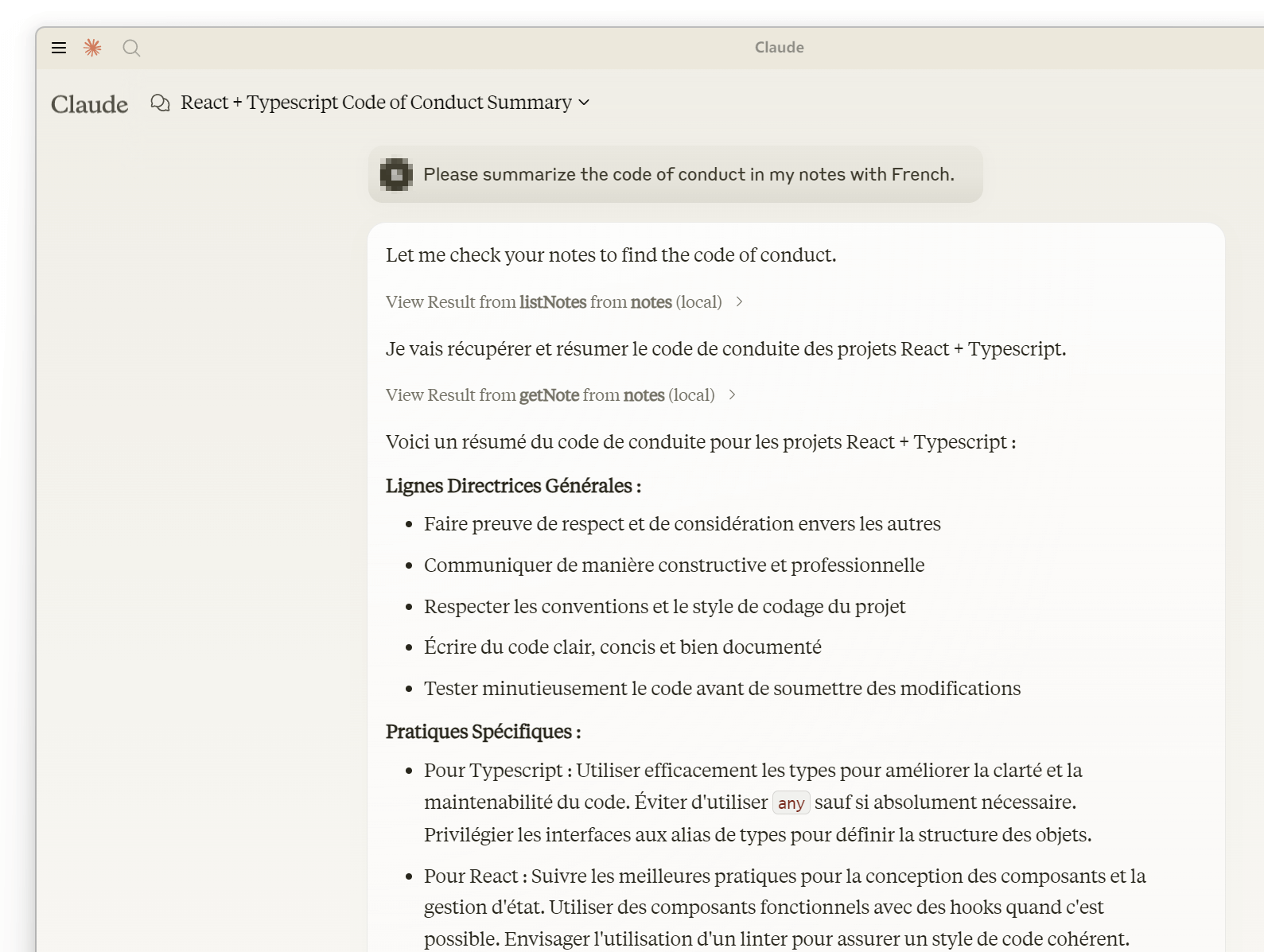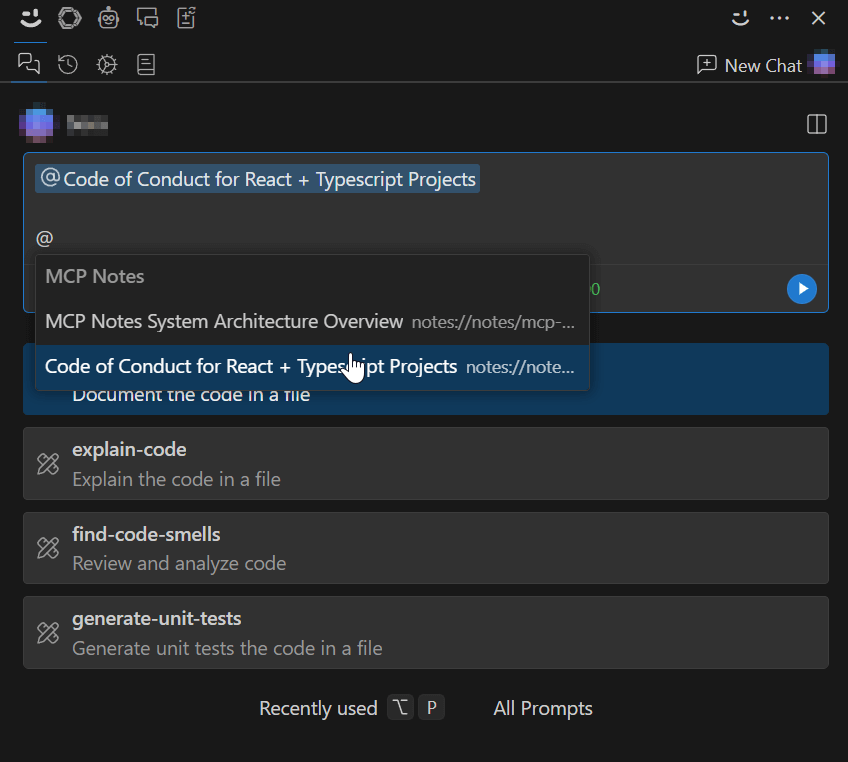A simple note-taking MCP server for recording and managing notes with AI models.

MCP Notes Server is a simple note-taking application built on top of the MCP protocol. Its purpose is to enable users to record and view complex notes and tasks while utilizing AI models, such as recording personal thoughts, notes, inspirations, and insights. It does not rely on creating project files, allowing users to record any content without making it public within the project.
This project includes two servers: a Node.js server using the Model Context Protocol (MCP) for AI-driven note management and a web server providing a user-friendly interface for manual interaction with your notes.
Note: This project requires DynamoDB for note storage. You’ll need an AWS account to use it. AWS offers a generous free tier for DynamoDB, making it suitable for frequent personal use at no cost.
You can use any model that supports function calls as long as your client supports MCP. The following models have been tested and confirmed to work:
Recommended
Run directly with npx or bunx, see examples below.
Alternative
npm installdynamodb://<access_key>:<secret_key>@<region>/<table>
Example:
dynamodb://AKIAXXXXXXXX:SKXXXXXXXX@us-east-1/mcp-notes
AWS_ACCESS_KEY_ID and AWS_SECRET_ACCESS_KEY.dynamodb://us-east-1/mcp-notesAdd this snippet to claude_desktop_config.json:
{
"mcpServers": {
"mcp-notes": {
"command": "npx",
"args": [
"-y",
"-p",
"mcp-notes",
"mcp-notes-server",
"--dynamodb",
"dynamodb://access_key:secret_key@region/table"
]
}
}
}
or file on local disks:
{
"mcpServers": {
"mcp-notes": {
"command": "node",
"args": [
"file://path/to/notes-mcp-server.js",
"--dynamodb",
"dynamodb://access_key:secret_key@region/table"
]
}
}
}
Note: Currently, Cody has limited MCP server support.
It only allows one server connection and cannot make tool calls. You’ll need to use the web interface to create and manage notes and then reference them in AI chat conversations.
Add this snippet to your VS Code settings:
{
"openctx.providers": {
"https://openctx.org/npm/@openctx/provider-modelcontextprotocol": {
"nodeCommand": "node",
"mcp.provider.uri": "file://path/to/notes-mcp-server.js",
"mcp.provider.args": [
"--dynamodb",
"dynamodb://access_key:secret_key@region/table"
]
}
}
}
alternatively, use with npx (not guaranteed to work):
{
"openctx.providers": {
"https://openctx.org/npm/@openctx/provider-modelcontextprotocol": {
"nodeCommand": "node",
"mcp.provider.uri": "file:///usr/local/bin/npx",
"mcp.provider.args": [
"-y",
"-p",
"mcp-notes",
"mcp-notes-server",
"--dynamodb",
"dynamodb://access_key:secret_key@region/table"
]
}
}
}
Add this snippet to cline_mcp_settings.json:
You will find a “MCP Server” icon next to the “New Task” button, and then there is an “Edit MCP Settings” button to open this file.
{
"mcpServers": {
"mcp-notes": {
"command": "npx",
"args": [
"-y",
"-p",
"mcp-notes",
"mcp-notes-server",
"--dynamodb",
"dynamodb://access_key:secret_key@region/table"
]
}
}
}
The web server provides a user-friendly interface for managing your notes. You can launch web interfaces to manage your notes, add new notes for AI, or modify parts of AI-generated notes.
npx -p mcp-notes mcp-notes-web-server --dynamodb "dynamodb://access_key:secret_key@region/table"
bun src/notes-web-server.ts --dynamodb "dynamodb://access_key:secret_key@region/table"
Alternatively, compile with
npm run buildand runnode dist/notes-mcp-server.jsornode dist/notes-web-server.js
Then navigate to http://localhost:3100 in your browser to view notes.
{ tags?: string[] }{ id: string }{ id: string, title: string, summary: string, tags: string[], content: string }{ id: string }Notes are stored using the following structure:
id: A unique identifier for the note. It should be descriptive, with a random number suffix, like “meeting-notes-1362”.title: The title of the note.summary: A short summary of the note’s content.tags: An array of tags associated with the note (e.g., [“meeting”, “project-x”]).content: The main content of the note.✅ Full functionality


✅ Mention Notes via Resource
❎ Tool calls are not supported

✅ Full functionality with Tool Calls
❓ Resources don’t seem to work; help wanted.

Mcp2serial
A open-source library enabling AI models to control hardware devices via serial communication using the MCP protocol. Initial support for Raspberry Pi Pico.
Resend Mcp
A MCP server for Resend API. Let LLMs compose and send emails for you.
Mcp Twitter Server
Model Context Protocol Server for Accessing twitter
An MCP server that provides LLMs access to other LLMs
An MCP server that provides tools for retrieving and processing documentation through vector search, both locally or hosted. Enabling AI assistants to augment their responses with relevant documentation context.
An MCP server for accessing data from Data.gov, providing tools and resources for interacting with government datasets.
Connects MCP to major 3D printer APIs (Orca, Bambu, OctoPrint, Klipper, Duet, Repetier, Prusa, Creality). Control prints, monitor status, and perform advanced STL operations like scaling, rotation, sectional editing, and base extension. Includes slicing and visualization.